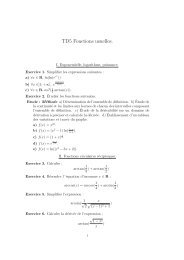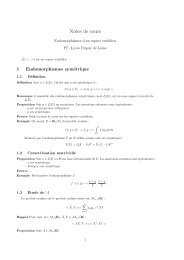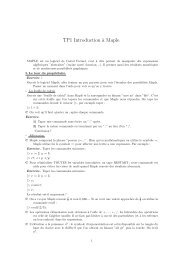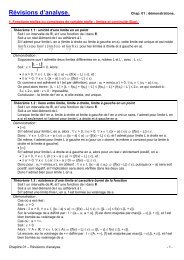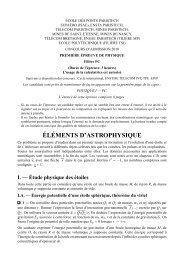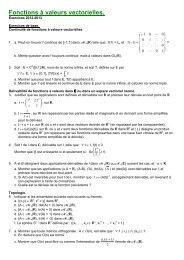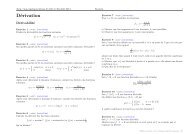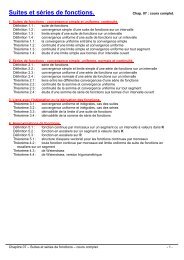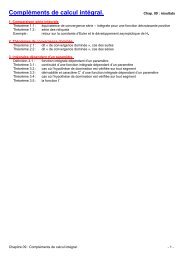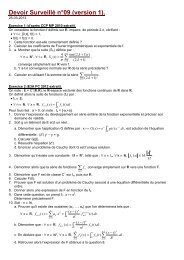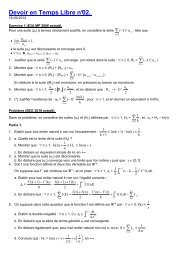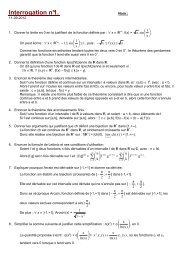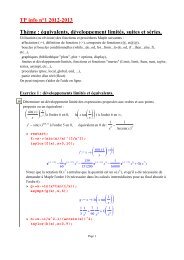[http://mp.cpgedupuydelome.fr] édité le 4 juin 2013 Enoncés 1 ...
[http://mp.cpgedupuydelome.fr] édité le 4 juin 2013 Enoncés 1 ...
[http://mp.cpgedupuydelome.fr] édité le 4 juin 2013 Enoncés 1 ...
Create successful ePaper yourself
Turn your PDF publications into a flip-book with our unique Google optimized e-Paper software.
[<strong>http</strong>://<strong>mp</strong>.<strong>cpgedupuydelome</strong>.<strong>fr</strong>] <strong>édité</strong> <strong>le</strong> 26 juil<strong>le</strong>t <strong>2013</strong> Corrections 79<br />
Exercice 124 : [énoncé]<br />
I) a) La fonction f est de classe C 1 par morceaux et régularisée donc par <strong>le</strong><br />
théorème de Dirich<strong>le</strong>t, sa série de Fourier converge si<strong>mp</strong><strong>le</strong>ment vers f.<br />
b) La fonction f est i<strong>mp</strong>aire donc an = 0 et<br />
bn = 2<br />
π<br />
La série de Fourier de f est<br />
π<br />
0<br />
<br />
n1<br />
n+1 2<br />
t sin(nt) dt = (−1)<br />
n<br />
n+1 2<br />
(−1)<br />
n sin(nt)<br />
II) a)ker h ⊂ ker f donc dim ker h dim ker f.<br />
En appliquant la formu<strong>le</strong> du rang à f et à h on obtient<br />
On en déduit<br />
dim ker f = n − rgf et dim ker h = rgg − rgh<br />
rgf + rgg − n rgh<br />
Or Im(f ◦ g) = Imh donc rg(f ◦ g) = rgh et on peut conclure.<br />
b) Un endomorphisme f vérifie f 2 = 0 si, et seu<strong>le</strong>ment si, Imf ⊂ ker f ce qui<br />
entraîne, en dimension 3, rgf = 1.<br />
Si l’endomorphisme f n’est pas nul, en choisissant x ∈ E tel que x /∈ ker f et en<br />
co<strong>mp</strong>létant <strong>le</strong> vecteur f(x) ∈ ker f, en une base (f(x), y) de ker f, on obtient que<br />
la matrice de f dans la base (x, f(x), y) est<br />
⎛<br />
⎝<br />
0 0 0<br />
1 0 0<br />
0 0 0<br />
Inversement, un endomorphisme f représenté par une tel<strong>le</strong> matrice vérifie f 2 = 0.<br />
Exercice 125 : [énoncé]<br />
I) La dernière équiva<strong>le</strong>nce provient du théorème d’inversibilité des matrices<br />
carrées.<br />
u est orthogonal ⇔ ∀x, y ∈ E, (u(x) | u(y)) = (x | y).<br />
Or (u(x) | u(y)) = (u ⋆ (u(x)) | y) donc u est orthogonal<br />
⇔ ∀x, y ∈ E, (u ⋆ (u(x)) − x | y) = 0.<br />
Or seul <strong>le</strong> vecteur nul est orthogonal à tout autre donc u est orthogonal<br />
⇔ ∀x ∈ E, u ⋆ ◦ u(x) = x.<br />
⎞<br />
⎠<br />
Or tP P est la matrice de u⋆ ◦ u donc u est orthogonal si, et seu<strong>le</strong>ment si,<br />
tP P = In.<br />
II) a) f admet une limite en +∞ car el<strong>le</strong> est décroissante. Cette limite ne peut<br />
être infinie ou finie non nul<strong>le</strong> donc f tend vers 0 en +∞ et puisqu’el<strong>le</strong> est<br />
décroissante el<strong>le</strong> est positive.<br />
b) f étant décroissante, hf((n + 1)h) (n+1)h<br />
f(t)dt hf(nh). Il suffit de<br />
nh<br />
sommer pour n ∈ {0, . . . , N − 1}.<br />
c) N<br />
f(nh) <br />
n=1<br />
1<br />
Nh<br />
h f(x)dx 0<br />
1<br />
+∞<br />
h f(x)dx et f(nh) 0 donc 0<br />
f(nh)<br />
converge.<br />
En passant à la limite quand N → +∞ l’encadrement du b) :<br />
h +∞<br />
f(nh) <br />
n=1<br />
+∞<br />
f(x)dx h 0<br />
+∞<br />
f(nh)<br />
n=0<br />
donc +∞<br />
f(x)dx h 0<br />
+∞<br />
f(nh) <br />
n=0<br />
+∞<br />
f(x)dx + hf(0).<br />
0<br />
A la limite quand h → 0 : h +∞<br />
f(nh) → +∞<br />
f(x)dx.<br />
0<br />
n=0<br />
Exercice 126 : [énoncé]<br />
I) On évalue +∞<br />
(n2 + 3n + 1)xn = x2−2x−1 (x−1) 3<br />
n=0<br />
II) C’est une cardioïde.<br />
en x = 1<br />
2 . On obtient 14.<br />
Exercice 127 : [énoncé]<br />
I) a) Posons n = dim E, p = dim A.<br />
Soit (e1, . . . , ep) une base orthonorma<strong>le</strong> de A que l’on co<strong>mp</strong>lète en (e1, . . . , en)<br />
base orthonorma<strong>le</strong> de E.<br />
x ∈ A ⊥ ⇔ ∀i ∈ {1, . . . , p} , (ei | x) = 0<br />
donc A ⊥ = Vect(ep+1, . . . , en) puis E = A ⊕ A ⊥ .<br />
b) On a dim A ⊥ = n − dim A et donc dim A ⊥⊥ = dim A.<br />
II) a) On parvient à<br />
y(t) =<br />
de rayon de convergence R = +∞.<br />
En d’autres termes<br />
y(t) =<br />
+∞<br />
p=0<br />
t 2p<br />
(2p + 2)!<br />
ch(t) − 1<br />
t 2<br />
Diffusion autorisée à titre entièrement gratuit uniquement - dD


![[http://mp.cpgedupuydelome.fr] édité le 4 juin 2013 Enoncés 1 ...](https://img.yumpu.com/19249082/79/500x640/http-mpcpgedupuydelomefr-edite-le-4-juin-2013-enonces-1-.jpg)
